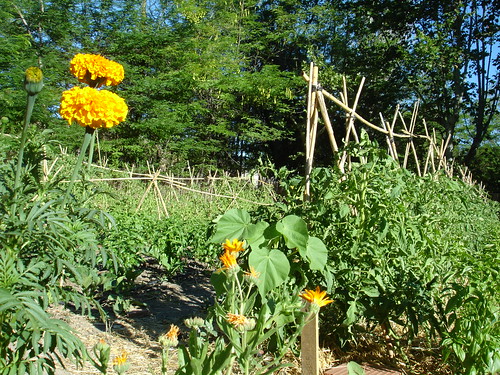 |
| Foto de Cantarranas |
Algo ten tocar a terra que nos fai máis felices. A vós tamén vos ocorre que preferides deitarvos sobre a herba que nunha tumbona? (en galego poderíamos propoñer estomballona, de estomballarse)
Facer murallas de area na praia, xogar cos coches na terra negra do patio da escola, correr esquivando pozas que duran nove meses no mesmo camiño... tamén a vós vos fai sentir fortes, libres, creativos, capaces, felices?
En Lugo a terra está sempre presente: nacen herbas en cada xunta de formigón por moi enxeñeirilmente selada que estea. En Lugo, alí onde a cidade perde o seu casto nome, é dicir, pasadas as Gándaras cara Outeiro de Rei, un nutrido grupo de persoas comparten un terreo tradicionalmente chamado "A Alimaña" para cultivaren verduras, froitas e cereais en máis de dezasete parcelas de dez por dez metros. Non precisamos máis de cen metros cadrados para tocar a terra coas mans. E recoller os seus froitos.
En Tres Cantos, ao norte de Madrid, no que podería ser un deserto solar da periferia, medra un centro. Un centro como o de Lugo, un centro de parcelas, verduras e rego por goteo.
No campus da Universidad Complutense de Madrid seica hai unha horta comunitaria - aula de agroecoloxía, de nome Cantarranas. Alí decidín facer a miña próxima "toma de terra".
Hoxe na revista Nature vin un titular impactante sobre insectos que realizan a fotosíntese, tarefa que moitas persoas pensabamos que só realizaban as plantas. Deixo aí o dato.
Saúde e terra.
There is something about touching the land/ground/soil that makes us happier. Do you also prefer lying on the grass rather than in a lawn chair?
Building sand walls at the beach, playing with cars at the black soil of the school playground, running through the puddles... do this activities make you strong, free, creative, capable, happy?
The land is always present at Lugo: the grass grows into every fracture in the concrete, no matter the qualitiy of the construction. There is an important group of people there sharing a land traditionally known as "A Alimaña". They grow vegetables, fruits and cereals in more than seventeen plots of a hundred square meters each. Enough for touching the ground with our own hands. And enough for collect its fruits.
At Tres Cantos, north of Madrid, what could be an empty plot in the suburbs is nevertheless a center. A center similar to the one in Lugo, a center of vegetables and trickle irrigation.
There is still another interesting land at the Universidad Complutense in Madrid: a communal organic vegetable garden called Cantarranas. I have just decided to do my next "earth wire" there.
I have read an astonishing new in Nautre today: some insects do photosynthesis. Not only vegetables now. Just for you to know.
There is something about touching the land/ground/soil that makes us happier. Do you also prefer lying on the grass rather than in a lawn chair?
Building sand walls at the beach, playing with cars at the black soil of the school playground, running through the puddles... do this activities make you strong, free, creative, capable, happy?
The land is always present at Lugo: the grass grows into every fracture in the concrete, no matter the qualitiy of the construction. There is an important group of people there sharing a land traditionally known as "A Alimaña". They grow vegetables, fruits and cereals in more than seventeen plots of a hundred square meters each. Enough for touching the ground with our own hands. And enough for collect its fruits.
At Tres Cantos, north of Madrid, what could be an empty plot in the suburbs is nevertheless a center. A center similar to the one in Lugo, a center of vegetables and trickle irrigation.
There is still another interesting land at the Universidad Complutense in Madrid: a communal organic vegetable garden called Cantarranas. I have just decided to do my next "earth wire" there.
I have read an astonishing new in Nautre today: some insects do photosynthesis. Not only vegetables now. Just for you to know.
Ningún comentario:
Publicar un comentario